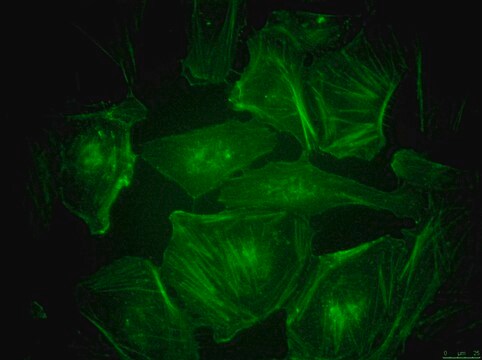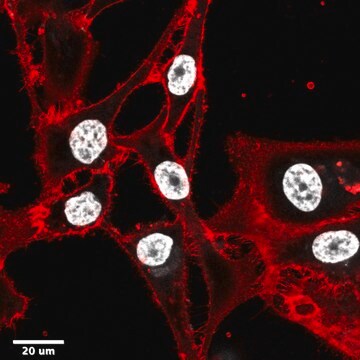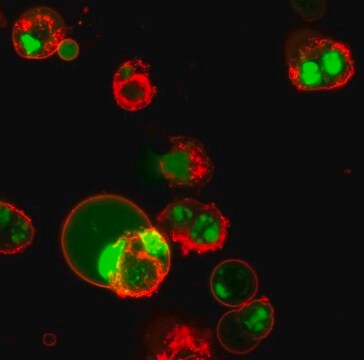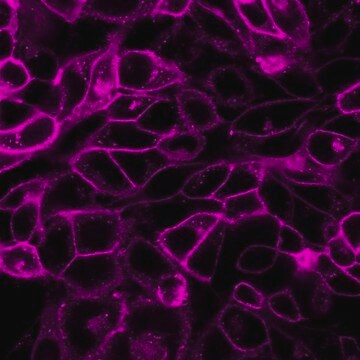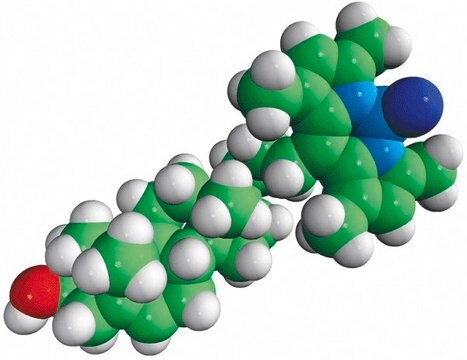SCT089
BioTracker™ rRNA Live Cell Probe
Fluorescent detection of ribosomal RNA and cell nucleoli
Sinonimo/i:
live cell probe, nucleoli probe, nucleolus probe, rRNA dye, rRNA probe, ribosomal RNA probe
Autenticatiper visualizzare i prezzi riservati alla tua organizzazione & contrattuali
About This Item
Codice UNSPSC:
12171501
NACRES:
NA.31
Prodotti consigliati
Livello qualitativo
Forma fisica
solid
Condizioni di spedizione
ambient
Temperatura di conservazione
2-8°C
Descrizione generale
The BioTracker™rRNA live cell probe is a styryl quinolinium dye that selectively binds ribosomal RNA (rRNA) in the cytoplasm and nucleoli of mammalian cells 1. This probe is a fluorescent small molecule that demonstrates high affinity to rRNA and therefore enables imaging of the nucleolus. Due to its low cytotoxicity, it enables detection in living systems with minimal interference.1 . As imaging technologies progress, there is increased demand for reagents that can detect diverse organoids and enable observation of subcellular functions in living cells. The optimal fluorescent reagent for live cell imaging should show high specificity to target along with low cytotoxicity 2 . Because the nucleolus is a dense organoid composed of chromatin and numerous protein components, the development of fluorescent reagents for live cell nucleoli detection is even more challenging 2,3,4. BioTracker™ rRNA live cell probe is easy to use, emits light in a longer wavelength to reduce phototoxicity and facilitate multiplexing, and can enhance nucleolar imaging dynamics.
Spectral Properties:Fluorescence images obtained by λex = 570 nm and emission at 647-667 nm.
Spectral Properties:Fluorescence images obtained by λex = 570 nm and emission at 647-667 nm.
Applicazioni
Live cell imaging probefor detection of ribosomal RNA (rRNA). Can also be used in fixed cell or tissuesamples, such as with a nuclear counterstain to identify nucleoli.
Qualità
Purity: ≥ 95% confirmed by HPLC. Molar Mass: 298 Da confirmed byLC-MS.
Stoccaggio e stabilità
Store BioTracker™ rRNA Live CellProbe at 2-8 °C, desiccated and protected from light
Note: Centrifuge vial briefly to collect contents at bottom ofvial before opening.
Note: Centrifuge vial briefly to collect contents at bottom ofvial before opening.
Note legali
BioTracker is a trademark of Merck KGaA, Darmstadt, Germany
Codice della classe di stoccaggio
11 - Combustible Solids
Classe di pericolosità dell'acqua (WGK)
WGK 3
Punto d’infiammabilità (°F)
Not applicable
Punto d’infiammabilità (°C)
Not applicable
Certificati d'analisi (COA)
Cerca il Certificati d'analisi (COA) digitando il numero di lotto/batch corrispondente. I numeri di lotto o di batch sono stampati sull'etichetta dei prodotti dopo la parola ‘Lotto’ o ‘Batch’.
Possiedi già questo prodotto?
I documenti relativi ai prodotti acquistati recentemente sono disponibili nell’Archivio dei documenti.
Red emissive cross-linked chitosan and their nanoparticles for imaging the nucleoli of living cells.
Ke Wang et al.
Carbohydrate polymers, 102, 699-707 (2014-02-11)
Biocompatible glutaraldehyde-cross-linked chitosan with new red fluorescence were prepared for the first time and were shaped into nanoparticles via inverse-microemulsion method. They could luminesce at ca. 670 nm either as powders and nanoparticles or in real and gelling solutions or
Applying styryl quinolinium fluorescent probes for imaging of ribosomal RNA in living cells
Abed Saadya, Eli Varonb, Avi Jacobb, Yaron Shav-Talb, Bilha Fischera
Dyes and Pigments, 174 (2020)
Tae-Keun Kim et al.
Cells, 8(7) (2019-07-13)
The cell nucleus is three-dimensionally and dynamically organized by nuclear components with high molecular density, such as chromatin and nuclear bodies. The structure and functions of these components are represented by the diffusion and interaction of related factors. Recent studies
Il team dei nostri ricercatori vanta grande esperienza in tutte le aree della ricerca quali Life Science, scienza dei materiali, sintesi chimica, cromatografia, discipline analitiche, ecc..
Contatta l'Assistenza Tecnica.